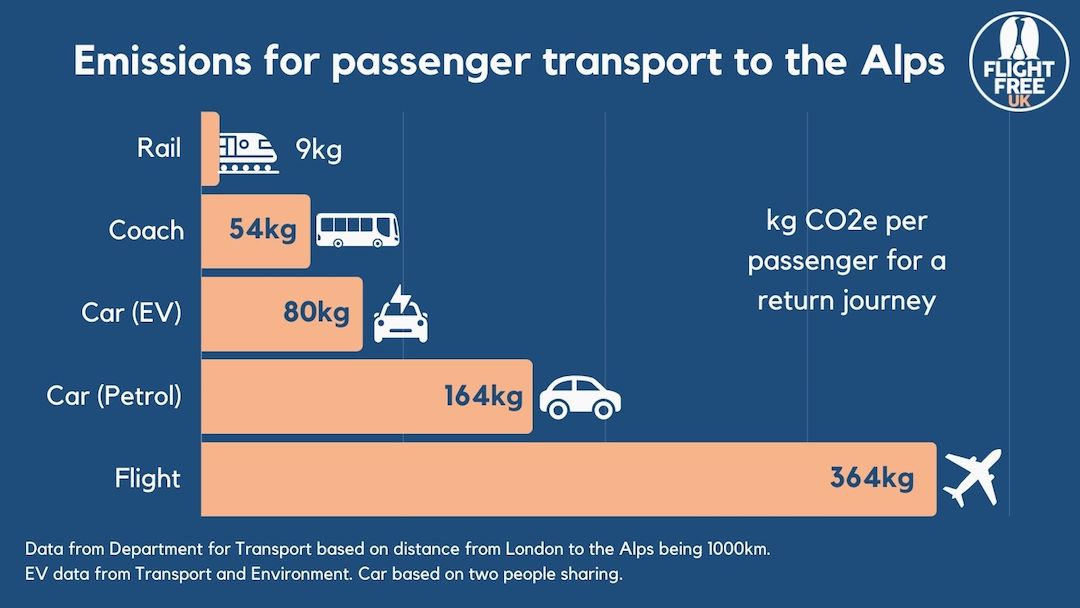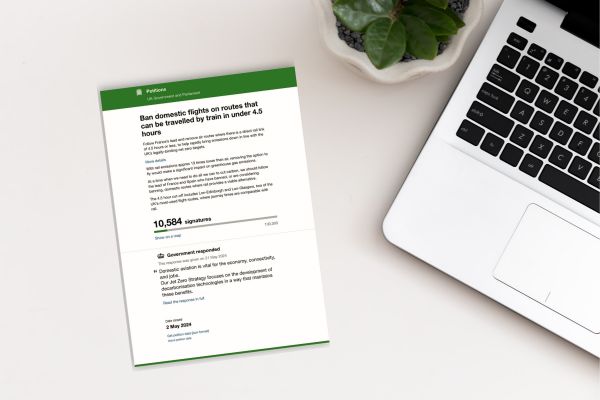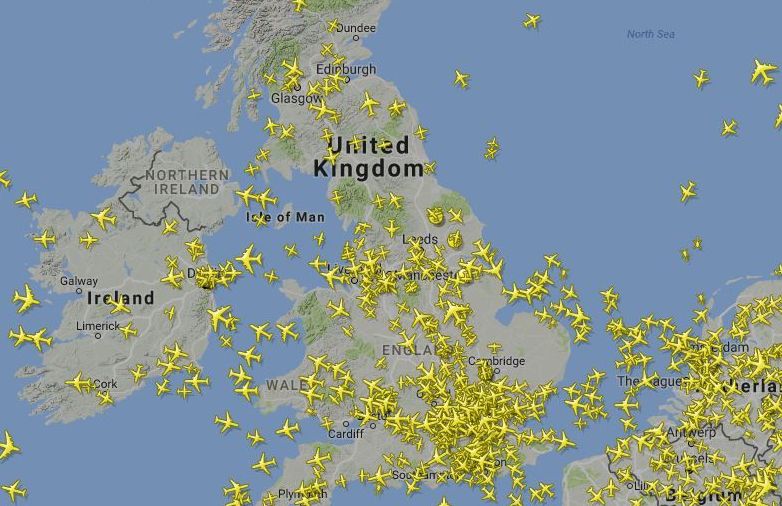
Skiing is perhaps one of the activities where it makes most sense to avoid a flight, given that the emissions from flights have a direct negative impact on the amount of snow to be found on the slopes.
Calculations suggest that over half of the emissions of your ski trip come from air travel, so choosing to travel in other ways can go a long way to ensuring there will be snow for many years to come.
There are plenty of options including coach and train travel, and the advantages don’t stop at the emissions savings: by travelling overland, you will often get an extra morning or day on the slopes compared to if you had flown.
The time taken to travel by train can be very similar to flying once you’ve factored in transfers and waiting around. In addition, taking your own kit can be much easier by train or coach as there are fewer restrictions on the amount of luggage you can bring.
So give flight-free travel a try for your next ski trip, and get your holiday off to a relaxed and low-carbon start.

Eurostar Snow Train (9kg CO2e)
Emissions per passenger for a return journey
The Eurostar Snow Train takes you to the Alps from London St Pancras via Lille and is run by Eurostar.
There is one service a week, departing on Saturday mornings, from 16 December 27 January. You’ll arrive that evening in the Tarentaise valley, the gateway to huge French ski resorts such as Tignes, Val d’Isere, Courchevel and Val Thorens.
The big advantage of this service is that the return journey is on the following Sunday morning, meaning you can ski seven days instead of the normal six if you fly. The return is during the day on the Sunday, leaving early and arriving back into London in the afternoon.
Train only tickets are available from Eurostar, with packages including your train travel, accommodation, transfer and lift pass available from Travelski and Inghams.
Other train options
The choice of resort and timings multiply significantly if you choose to change trains in Paris, opening up not only other French resorts, but other countries, including Switzerland, Austria and Italy.
Breaking the journey overnight in London or Paris is a great option if you’re travelling from the far reaches of the UK. Once in Paris, onward travel is usually from Gare de Lyon – a short journey across the city from Gare du Nord, where the Eurostar arrives.
The transfer between the two stations is very straightforward: just two stops on the Metro, taking 15 minutes. If it’s your first time, allow 90 minutes to make the connection.
The next leg of your journey will be on one of France’s super-fast TGV services. Depending on your destination you may need to change again, but in many cases you’ll be able to get off the train either in resort (e.g. St Anton, Chamonix) or only a short funicular ride away (Crans Montana, Les Arcs).
You can book the entire journey on websites like Rail Europe, either booking all legs in one go, or booking the Eurostar and SNCF (French Railways) legs separately, to give more flexibility over connection times.
Snowcoach and Snow Express (54kg CO2e)
Emissions per passenger for a return journey
Coach travel has changed a lot in recent years. Companies like Snowcoach offer spacious seats with good legroom, reclining seats and travel blankets. They are a tour operator with good value packages to resorts in France.
Snow Express is a weekly direct coach service from London to over 30 French ski resorts. Their coaches are equipped with free Wi-Fi and USB charging points.
In both cases, coaches leave on Friday evenings, arriving early on Saturday. They leave the following Saturday evening, getting back to the UK on the Sunday. This means that you can ski for a full eight days – a significant difference if you only take one ski holiday a year.
Find out what the Snow Express is like by reading Heather's account.
Driving – Petrol/Diesel Car (164kg CO2e)
Emissions per passenger for a return journey based on two people in the vehicle
Driving is an excellent option for families heading for the Alps. It does take longer (most ski resorts are 9-10 hours from Calais), but even taking into account fuel prices and road tolls, for a family of four, it’s typically cheaper than flying.
There are no baggage fees, so as long as you can fit your luggage in the boot or a roof box, you can take it at no extra cost. And, of course, you can drive right to the door of your accommodation with no waiting for taxis or transfer buses.
What you do need to consider are the requirements for driving in alpine conditions. In many countries snow chains or winter tyres are compulsory and driving on an icy road in a snowstorm can be a demanding experience.
Driving – Electric Car (80kg CO2e)
Emissions per passenger for a return journey based on two people in the vehicle
A really good option for keeping your carbon footprint to the minimum is to drive to the Alps in an electric car.
The various emissions of charging an electric vehicle are explained on the T&E website, and here we've gone for the EU average of battery manufacture and electricity production. The carbon cost of the drive is added to your Eurotunnel crossing – a measly 2kg CO2e per crossing.
The key issue for most people considering driving to a ski resort in an EV will be ‘range anxiety’. While there is an excellent charger network on Europe’s motorways, it’s not as comprehensive yet as the number of petrol stations.
Travelling to the Alps and back in electric vehicles is definitely achievable, but you do need to plan your journey around charge points, based on the ‘real range’ of your vehicle. Bear in mind that range reduces in the winter when the batteries are cold!
UK destinations
Of course, the easiest way to ski flight-free might be to stay in the UK! Resorts include Glencoe near Fort William, Glenshee and The Lecht in the Cairngorms, Helvellyn in the Lake District, and Weardale in Northumberland.
Even from the furthest reaches of the UK you could be in the Highlands in little over 24 hours, if you combine day trains with the Caledonian Sleeper.
Further reading and help
Ski Flight Free was set up by journalist and podcaster Iain Martin (who wrote most of this article – thanks Iain!). There you will find up-to-date information about services and routes to the Alps and other locations.
Also highly recommended is Snow Carbon, run by ski journalist Daniel Elkan, which tells you everything you need to know about getting to the slopes without flying. Daniel puts the train to the test in a race with a ski-journalist friend, to see who can reach the hottub at their Méribel resort first. Find out who won here.
Read about how Flight Free UK director Anna Hughes travelled to the Swiss Alps by train here.

Emissions data and calculations
We use Department for Transport emissions data to calculate the emissions for each journey. EV data comes from Transport and Environment.
- London-Alps = approx 1000km
- Rail (international) = 0.004459kg CO2e per passenger km = 4.459 per passenger for a 1000km journey, x 2 = 9kg CO2e per passenger per return journey
- Coach = 0.02718kg CO2e per passenger km = 27.18 per passenger for a 1000km journey, x 2 = 54kg CO2e per passenger per return journey
- Car (petrol) = 0.16391kg CO2e per km = 163.91 for a 1000km journey, x 2 = 328kg CO2e per return journey, ÷ 2 for two people in the vehicle = 164kg per passenger per return journey
- EV = 0.075kg CO2e per km = 75kg for a 1000km journey ÷ 2 for two people in the vehicle = 37.5kg, + 2 for Eurotunnel, x 2 for return journey = 80kg per passenger per return journey
- Flight (economy) = 0.18287kg CO2e per passenger km = 182.87 per passenger for a 1000km journey, x 2 = 364kg CO2e per passenger per return journey




